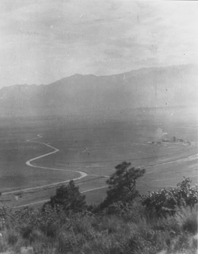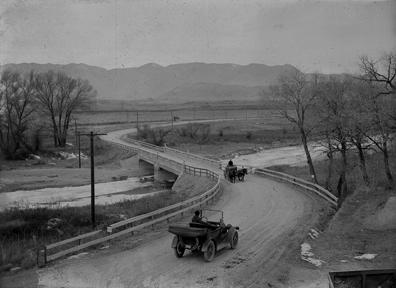
Starting place
Lincoln Center, 2727 North Cascade Ave.
Access
- Trail: Pikes Peak Greenway, turn east on Polk Ave.
- Car (parking): near Lincoln Center, 2727 North Cascade Ave.
- Mountain Metro Transit: Routes 9 and 19. For further information, use the Trip Planner at mmtransit.com.
- Bike Share: visit https://www.pikeride.org/ to find the nearest e-bike station.
Route Details
- Direction: Counterclockwise
- Distance: 8.8 mi
- Elevation: 368 ft
- Smaller loop options/places to cut across: Both Hancock Ave and the Templeton Gap Trail can provide shorter loops or less elevation gain. But there’s no shame in walking the hill up to UCCS!
- Connects to Pedal Our Past: Legacy Loop
Maps and Links
- Download PDF map and turn by turn directions
- Visit RidewithGPS for a map, turn by turn directions, stop info, and lots more!
- Download .gpx for use in other ride apps
Stop 1: Lincoln School
Lincoln elementary school was built in 1948 (although here was an older Lincoln school on South Cascade from 1886 to 1920). As families continue moving to suburbs, this school closed in 2013 then shortly after was redeveloped with shops, a brewery, offices, and restaurants. The site is now a community gathering spot.
Stop 2: Penrose Hospital
Marie Glockner funded a sanatorium in memory of her husband Albert who succumbed to the disease in 1888. This Catholic institution opened in 1888. By 1905 there was a 38-room sanatorium and 18-room general hospital.
Stop 3: AT&SF Railroad
The Atchison, Topeka & Santa Fe Railroad was the main competition for General Palmers Denver & Rio Grande line. This bike trail follows the Santa Fe route through town, where its depot is still located on East Pikes Peak Avenue. The last train ran in 1971.
Stop 4: Rock Island Railroad
The Chicago, Rock Island, and Pacific Railroad was Colorado Springs’ direct connection to Chicago and the Midwest. It ran from 1888 to 1979. These tracks were finally removed in 2013. The trolley museum occupies what was the roundhouse for this railroad company.
Stop 5: Nordrach Ranch
Nordrach Ranch Sanatorium was just to the east of this spot, one of the city’s many tuberculosis sanatoriums. This operated from 1901-1913 and had dozens of Gardiner TB huts for residents, whose treatment included large meals emphasizing meat and milk
Stop 6: Palmer Park

Stop 7: Cragmor Sanitorium
The Cragmor Sanatorium was one of the most exclusive tuberculosis sanatoriums in the country. It operated from 1905 until 1962, after which the buildings and grounds were sold to the University of Colorado for $1.
Stop 8: Portal Park
In this park were the entrances to two coal mines—Curtis and Patterson. The voids in the old coal works underground created a sinkhole in the baseball center field and cracking in the pool foundation in 1979. Both mines were closed by 1924.
Stop 9: Subsidence
An unexpected surprise from the region’s coal mining past occurred when a 10-foot wide hole suddenly appeared on Mariposa Street in the Cragmor neighborhood just north of here on August 14, 2017, after a particularly rainy summer. City workers quickly filled the pit, but the asphalt settled another 8” within a week, requiring more extensive excavation and compaction to stabilize the unconsolidated muck below street level.
Stop 10: Templeton Gap
Templeton Gap is a small passage between Austin Bluffs and what is now Palmer Park. It was an alternate route north to Denver, connecting to Cherry Creek. This was also a hunting and shepherd area in the early days of the city. A reservoir impounded water from the bluffs in the early 20th century, and Union Boulevard was not completed through to Academy Boulevard until 1985.
Stop 11: Denver Highway and Flood
Just ahead of this spot Cascade Avenue dropped down to cross Monument Creek, then ran north as the main highway to Denver. In 1935 a devastating flood washed out this bridge and nearly every other crossing over Monument Creek. The highway moved to Nevada Avenue, until Interstate 25 was built in 1960.
Stop 12: Alexander Film & Aircraft
This headquarters was built in 1928 with filming studios and production laboratories. By the early 1950s, the Alexander Film Company was producing up to 3,000 films annually covering 8,200 different subjects. The Alexander Film Company became the world's largest producer of theater film advertising before its demise in the 1960s.
Stop 13: Roswell
Roswell was a suburban town built for workers of the Chicago, Rock Island & Pacific Railroad that connected to Colorado Springs in 1889. By the early 20th century a horse race track was built immediately west of this point, where Fillmore Street now runs. By the 1940s the track hosted car races as well. The town was annexed into Colorado Springs in 1950, and by the mid-1950s the track closed and Fillmore Street was completed between Cascade Avenue and I-25 in 1961.

For more information about Sesquicentennial events, visit COS150.
For more information about biking around the city, visit Bike Colorado Springs and the city’s bike page.
